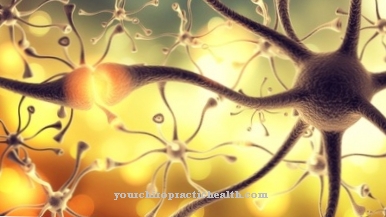The Gluconeogenesis ensures the new synthesis of glucose from pyruvate, lactate and glycerine in the body. This ensures the organism's glucose supply in times of hunger. Disturbances in gluconeogenesis can lead to dangerous hypoglycemia.
What is Gluconeogenesis?

During gluconeogenesis, glucose is generated again from the breakdown products of the protein, carbohydrate and fat metabolism.
The reactions to gluconeogenesis mainly take place in the liver and muscles. There the synthesized glucose is then condensed into glucogen, a storage substance that serves as an energy store for the rapid energy supply of nerve cells, erythrocytes and muscles. Through gluconeogenesis, 180 to 200 grams of glucose can be newly formed per day.
Gluconeogenesis can be viewed as the reverse of glycolysis (breakdown of glucose) to pyruvate or lactate, although three reaction steps have to be replaced by bypass reactions for energetic reasons. Glycolysis produces pyruvate (pyruvic acid) or, under anaerobic conditions, lactate (anion of lactic acid). Furthermore, pyruvic acid is also formed from amino acids when they are broken down. Another substrate for the regeneration of glucose is glycerine, which comes from the breakdown of fat. It is converted into dihydroxyacetone phosphate, which acts as a metabolite in the synthesis chain of gluconeogenesis to build up glucose.
Function & task
The question arises as to why glucose should be built up again if it was previously broken down by glycolysis to generate energy. It should be noted, however, that the nerve cells, the brain or the erythrocytes are dependent on glucose as an energy supplier.
If the body's supplies of glucose are used up without being replenished quickly enough, dangerous hypoglycemia occurs, which can even be fatal. With the help of gluconeogenesis, the normal blood sugar level can be kept constant even in times of hunger or in energy-consuming emergency situations.
One third of the newly synthesized glucose is stored as glucogen in the liver and two thirds in the skeletal muscles. If you are hungry for a longer period of time, the need for glucose drops slightly because the second metabolic pathway is the use of ketone bodies to generate energy.
The central role in gluconeogenesis is played by pyruvic acid (pyruvate) or the lactic acid (lactate) formed from it under anaerobic conditions. Both compounds are also breakdown products during glycolysis (breakdown of sugar).
In addition, pyruvate is also formed when amino acids are broken down. Elsewhere, glycerine from fat breakdown can also be converted into a metabolite of gluconeogenesis, and it is incorporated into this process. During gluconeogenesis, glucose is produced again from the breakdown products of the carbohydrate, protein and fat metabolism.
The body's own regulatory mechanisms ensure that gluconeogenesis and glycolysis do not take place at the same time. With increased glycolysis, gluconeogenesis is somewhat weakened. In a phase of increased gluconeogenesis, glycolysis is again reduced.
For this purpose, there are hormonal regulatory mechanisms in the organism. For example, if a lot of carbohydrates are consumed through food, the blood sugar level rises. At the same time, the production of insulin in the pancreas is stimulated.
Insulin provides the cells with glucose. There it is either broken down to generate energy or, if the energy requirement is low, it is converted into fatty acids that can be stored as triglycerides (fat) in adipose tissue.
If there is an insufficient supply of carbohydrates (hunger, extremely low-carbohydrate food or high glucose consumption in emergencies), the blood sugar level first drops. This calls the hormonal antagonist of insulin, the hormone glucagon, on the scene. Glucagon causes stored glucogen in the liver to break down into glucose. When these supplies are used up, the increased gluconeogenesis from amino acids for the new synthesis of glucose starts in the body if the hunger phase persists.
Illnesses & ailments
If gluconeogenesis is disrupted, the body may have low blood sugar (hypoglycaemia). Hypoglycemia can have many causes. For example, hormonal regulatory mechanisms lead to increased gluconeogenesis when there is an increased need for glucose or when the supply of carbohydrates is reduced.
The hormonal antagonist of insulin is the hormone glucagon. When the blood sugar level drops, the production of glucagon increases, which then causes increased gluconeogenesis. First, the glucogen stored in the liver and muscles is broken down and converted into glucose. When all glucogen reserves are used up, glucogenic amino acids are converted into glucose. Muscle breakdown takes place in order to supply the body with energy.
However, if gluconeogenesis is difficult to get going for various reasons, hypoglycaemia develops, which in severe cases can lead to unconsciousness and even death.
For example, liver diseases or certain drugs can hinder gluconeogenesis. The consumption of alcohol also inhibits gluconeogenesis. Severe hypoglycemia is an emergency that requires rapid medical attention.
Another hormone that promotes gluconeogenesis is cortisol. Cortisol is a glucocorticoid found in the adrenal cortex and acts as a stress hormone. Its task is to provide energy quickly in stressful physical situations. To do this, the physical energy reserves must be activated. Cortisol stimulates the conversion of amino acids in the skeletal muscles into glucose as part of gluconeogenesis.
If the adrenal cortex is overactive, for example due to a tumor, too much cortisol is constantly being produced. Gluconeogenesis then runs at full speed. The overproduction of glucose leads to muscle breakdown, a weakening of the immune system and trunk obesity. This clinical picture is known as Cushing's syndrome.

.jpg)

























